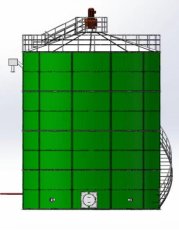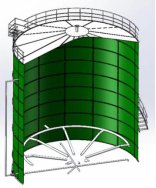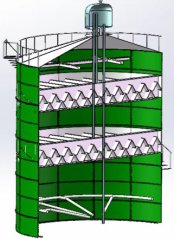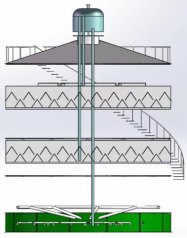Different Forms of Anaerobic Reactors Introduction
I. Completely Mixed Anaerobic Reactor (CSTR)
The Completely Mixed Anaerobic Reactor (CSTR) is an anaerobic treatment technology that achieves complete mixing of fermentation materials and microorganisms. The most typical feature is the installation of an agitator inside the tank to ensure a uniform state of the material system, facilitating uniform reactions and heat transfer. Parameters characterizing its reaction system include temperature, pH, carbon-nitrogen ratio, agitation rate, material concentration, etc. CSTR anaerobic reactors are generally divided into two types: independent (left image) and integrated (right image).


II. Upflow Anaerobic Sludge Blanket (UASB)
Upflow Anaerobic Sludge Blanket (UASB) reactors are used for the specific treatment of anaerobic reactors with high solid content. Its structural feature is the absence of a three-phase separator and mechanical stirring device inside the tank. Water is evenly distributed at the bottom of the tank, utilizing an upflow hydraulic circulation of clarified liquid. The produced biogas rises with the water flow, generating gas agitation to promote sufficient contact between microorganisms and materials. Due to gravity, there is a natural settling effect in the solid bed area, maintaining a higher sludge and anaerobic microbial content in the reactor. This ensures a longer retention time for microorganisms and solids.


III. Internal Circulation Anaerobic Reactor (IC)


The Internal Circulation Anaerobic Reactor (IC) is a new and efficient anaerobic reactor introduced by Paques, a Dutch company, in 1985. The IC reactor is composed of overlapping first and second anaerobic reaction zones, each with a three-phase separator at the top. In 1988, the first set of IC reactors was put into use, and China introduced IC technology in 1996. The biological degradation in IC reactors is divided into two stages, with the first reaction zone at the bottom operating at a high load and the upper second reaction zone at a low load. Influent enters the first reaction zone from the bottom, mixing thoroughly with anaerobic activated sludge. Most organic substances are degraded into biogas in this zone, and the generated biogas is collected by the gas hood of the three-phase separator and rises along the biogas riser. Simultaneously, it lifts the mixed liquid from the bottom of the first reaction zone to the top gas-liquid separator, where the biogas is released from the top. The separated slurry-water mixture returns to the bottom of the first reaction zone through the slurry return pipe and mixes thoroughly with the bottom granular sludge and influent, achieving internal sludge circulation. The result of internal circulation is not only a high microbial content and a long sludge age in the first reaction zone but also a significant upflow velocity, generally ranging from 10-20 m/h, allowing the granular sludge to reach a completely fluidized state and greatly improving the organic degradation rate. The reaction process in the second reaction zone is essentially the same as in the first reaction zone, but the upflow velocity is significantly reduced, generally ranging from 2-10 m/h.
The next article will discuss the advantages and disadvantages of three different types. Stay tuned!